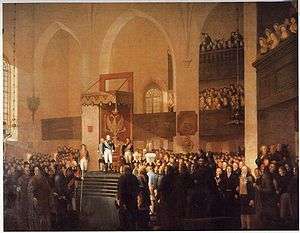Diet of Porvoo

The Diet of Porvoo (Finnish Porvoon maapäivät, or unhistorically Porvoon valtiopäivät;[1] Swedish Borgå landtdag), was the summoned legislative assembly to establish the Grand Principality of Finland in 1809 and the heir of the powers of the Swedish Riksdag of the Estates. The session of the Diet lasted from January to July 1809.

During the Finnish War between Sweden and Russia, the four Estates of Russian occupied Finland (Nobility, Clergy, Burghers and Peasants) were assembled at Porvoo (Borgå) by Tsar Alexander I, the new Grand Prince of Finland, between 25 March and 19 July 1809. The central event at Porvoo was the sovereign pledge and the oaths of the Estates in Porvoo Cathedral on 29 March. Each of the Estates swore their oaths of allegiance, committing themselves to accepting the Emperor as Grand Prince of Finland as the true authority, and to keeping the constitution and the form of government unchanged. Alexander I subsequently promised[2] to govern Finland in accordance with its laws and let the Finnish keep their religion and rights. This was thought to essentially mean that the emperor confirmed the Swedish Instrument of Government from 1772 as the constitution of Finland, although it was also interpreted to mean respecting the existing codes and statutes.[3]
The diet had required that it would be convened again after the Finnish War, which separated Finland from Sweden, had been concluded. On 17 September the same year, the conflict was settled by the Treaty of Fredrikshamn but it would be another five decades until the Finnish Estates would be called again.
During the rise of Finnish nationalism later in the 19th century, it was claimed that the Diet implied that a Treaty between States had been signed at the Diet between Finland and Russia. According to Emeritus Professor Jussila of Helsinki University, it is true that Alexander said that Finland had been raised to the status of a nation among nations, but the claim of a Treaty between equals was simply a device invented for the political realities of the struggle for independence.
Participants
Diet had participants from different estates as follows:[4]
- Nobility 75 representatives, chairman lantmarskalk count Robert Wilhelm De Geer.
- Clergy 8 representatives, chairman bishop of Turku Jakob Tengström
- Burghers 20 representatives, chairman merchant Kristian Trapp, Turku
- Peasants 31 representatives, chairman Pehr Klockars Uusikaarlepyy
Out of 205 noble families 130 were not represented in the diet, and 60 of the representatives did not attend the opening ceremony. The burghers were mainly represented by merchants.[5]
See also
- Diet of Finland
- Parliament of Finland
- Senate of Finland
- Governor-General of Finland
- Finnish nobility
- Finnish House of Knights and Nobility
- Kingdom of Finland (1742)
References
- ↑ The Finnish word for a Diet, "valtiopäivät", was invented only in the mid-19th century, so calling the lantdag in Porvoo with that name is unhistorical. The Swedish name for the Finnish parliament was lantdag up until 1919, when it was officially changed to riksdag. To be noted however is that the Russian Emperor used the French word for Diet when he addressed the estates.
- ↑ The declaration by the tsar at the diet of Porvoo, as officially translated, reprinted by Kustavi Grotenfelt [1861-1928]: Suomenkielisiä historiallisia asiakirjoja Ruotsin vallan ajalta (vuosilta 1548-1809), Helsinki 1912; at Wikisource: Julistus Suomen entisen uskonnon ja perustuslakien vahvistamisesta.
- ↑ "The Diet of Porvoo". 1809 - building a nation. Prime Minister's Office. Retrieved November 24, 2015.
- ↑ "Porvoon valtiopäivärakennukset 200 vuotta sitten ja nykyään". Porvoo (in Finnish). Porvoo city. Retrieved November 24, 2015.
- ↑ "Members of the Estates". 1809 - building a nation. Prime Minister's Office. Retrieved November 24, 2015.
External links
- History of the Finnish Parliament - Official site
- Kejsarens tal vid lantdagens avslutande den 19 juli 1809 - in Swedish at Wikisource (Originally in French)
- The Porvoo Diet 1809 - The Beginning of Autonomous Finland Porvoo Town
- The Diet of Porvoo 1809
Coordinates: 60°24′N 25°40′E / 60.400°N 25.667°E